The 2019 CWDI Report focuses on women board directors in 104 banks, insurance and mortgage companies in the 2018 Fortune Global 500 ranking of the largest in the world. The data on women board directors and executive officers is valid as of December 31, 2018.
Key Findings
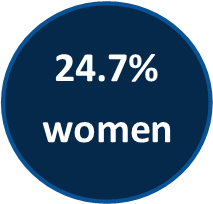 Men continue to dominate the boardrooms of the world’s largest financial services companies ranked in the Fortune Global 500 listing (75.3%). Women account for only 24.7% of all director positions on these boards but double the percentage in 2005 at 10.3%.
Men continue to dominate the boardrooms of the world’s largest financial services companies ranked in the Fortune Global 500 listing (75.3%). Women account for only 24.7% of all director positions on these boards but double the percentage in 2005 at 10.3%.
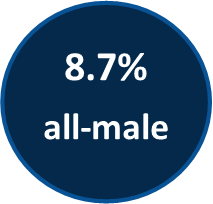 However, the majority of these large financial institutions now have women board directors. Only 9 of the 104 companies in the Fortune listing – 8.7% – have all-male boards.
However, the majority of these large financial institutions now have women board directors. Only 9 of the 104 companies in the Fortune listing – 8.7% – have all-male boards.
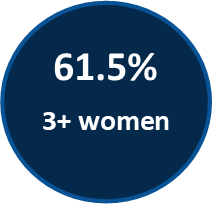
Equally striking is that 61.5% of these boards have reached ‘critical mass’ with three or more women holding board seats compared to only 17% in 2005.
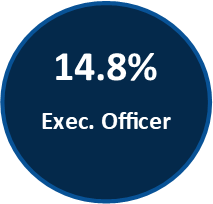
Unfortunately, this increase in women directors in these financial institutions has not yet come with commensurate increase in women in executive positions. Only 14.8% of executive officers are women.
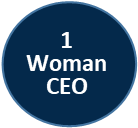 Only 1 company out of the 104 largest banks and financial institutions globally has a woman CEO – Progressive Insurance -- which has 45.5% women directors, ranking third among best performing companies.
Only 1 company out of the 104 largest banks and financial institutions globally has a woman CEO – Progressive Insurance -- which has 45.5% women directors, ranking third among best performing companies.
Best Performers
- Among the Top Ten Companies with the highest percentage of women directors are two insurance firms, which have achieved 50-50 male-female representation on their Boards of Directors: AXA, headquartered in France, and Achmea, based in the Netherlands.
- French companies dominate the Top Ten listing with its six companies averaging 44.6% women-held board seats – Groupe BPCE, BNP Paribas, Credit Agricole, Societe Generale, and CNP Assurances, in addition to AXA.
A look at the Top Twenty Best Performers, however, shows U.S. companies dominating with 13 in the listing with about 30% women’s board representation. Three U.S. financial services companies – Progressive Insurance, TIAA, and Wells Fargo – fare better averaging 43.7% women directors.
Why?
- The majority of best performing companies, whether in the Top 10 or Top 20, in appointing women directors tend to be based in Europe, where legislative mandates -- quotas of 30-40% -- have moved companies to comply. Most were enacted from 2011 onwards and accelerated women’s board appointments in the region.
- Best performing companies in countries without quotas had national initiatives advanced by the private sector to increase the number of women directors. Australia – with 4 companies in the Top 20 – has a stock exchange (ASX) which made gender diversity a listing requirement. The U.K. – with 3 companies in the Top 20 – had a commission-driven board diversity effort led by Lord Davies which set a target of 25% women directors in the FTSE100 by 2017, which was reached and now raised to 30%. Canada’s stock exchange (TSX) has a comply-and-explain directive to its member companies to report on board diversity make-up and policies.
- Countries without nationally-driven initiatives to increase women’s board representation had lower percentages of women directors.
- The U.S. does not have such a nation-wide program, so while its 26 financial services companies had the largest presence in the Fortune Global 500 listing, the S. averaged only 28.9% women directors, well behind its European counterparts except for the three mentioned above.
- China, the second largest economy in the world, also lacks a national initiative to appoint more women to board seats. As a result, China’s percentage of women board directors in its largest banks remains low at 10.8%.
- National initiatives, whether government- or business-led, to increase the number of women board directors have resulted in more women in the boardroom. Companies in countries with quota legislation averaged 36.1% women directors while companies in countries without mandates averaged only 21%. In addition, companies in countries with private-sector driven efforts also outpaced those in countries without any initiative by a margin of 32.3% to 18.6%.
Women Executive Officers
- The percentage of women executive officers in the largest banks and financial services companies significantly trails the percentage of women board directors. With 14.8% of executive officer positions held by women, men dominate C-suite positions.
- Companies with high percentages of women board directors do not necessarily correlate with a high percentage of women executive officers.
- Ranked first in the Top Ten list of best performing companies is J.P. Morgan Chase with 45.5% women in senior executive positions. Coming in second is France’s CNP Assurances at 41.7%, while the Netherlands’ Rabobank at 40% comes in third.
- While French companies outnumbered others in the Top Ten list of companies with the highest percentage of women directors, seven U.S. companies dominate the Top Ten list of companies with the highest percentage of women executive officers -- Northwestern Mutual, Bank of America, US Bancorp, Fannie Mae, American Express, Wells Fargo and P. MorganChase.
- In addition to having the only woman CEO, Progressive Insurance is one of five companies in the listing which also has a woman as Board Chair. The other four companies with women holding Chair positions are Royal Bank of Canada, Commonwealth Bank of Australia, Mizuho Financial Group, and Banco Santander. The percentage of women board directors on these five companies – 34.4% -- is significantly higher than the overall average of 24.7% in this industry. Women in top leadership positions do make a difference.
Why?
- While it may be easier to bring in external experienced and talented women to boards, it appears that companies need to work harder internally to ‘grow’ women’s executive talents.
- Companies who have succeeded in improving the numbers of women senior officers have set firm targets for doing so. It took Westpac 10 years to arrive at their stated target of 50% women in executive positions, but it held management at all levels accountable for reaching its corporate diversity goal under two successive CEOs by the deadline established by the bank.
- While there are no quotas for women senior executives, both the Netherlands and Japan have laws recommending that companies set targets for these positions, but there are no sanctions for not reaching such goals but merely requires an explanation and future plans.
Best Overall Performers
Five companies achieve “Best Companies for Women in Leadership” status with over 30% women’s representation for both board seats and executive officer appointments:
- Zurich Insurance
- Rabobank,
- CNP Assurances,
- Wells Fargo
- Australia & New Zealand Banking Group
Rabobank is the only company with over 40% in both top ten listings – 44.4% women board directors and 40% women executive officers.
